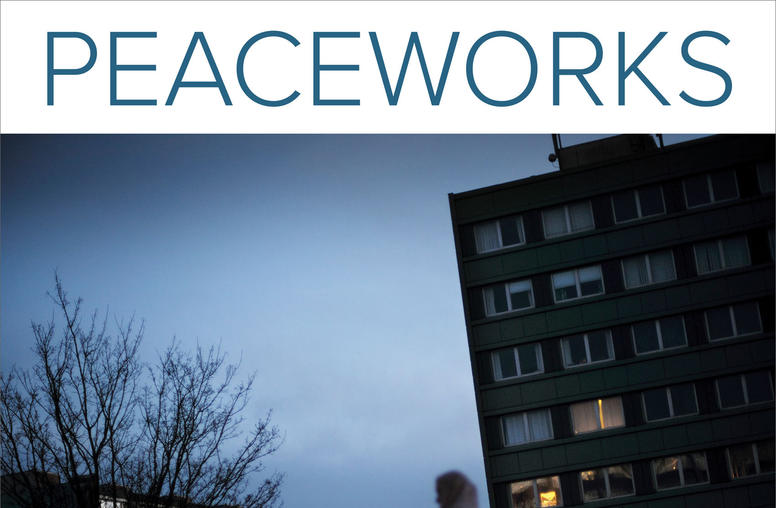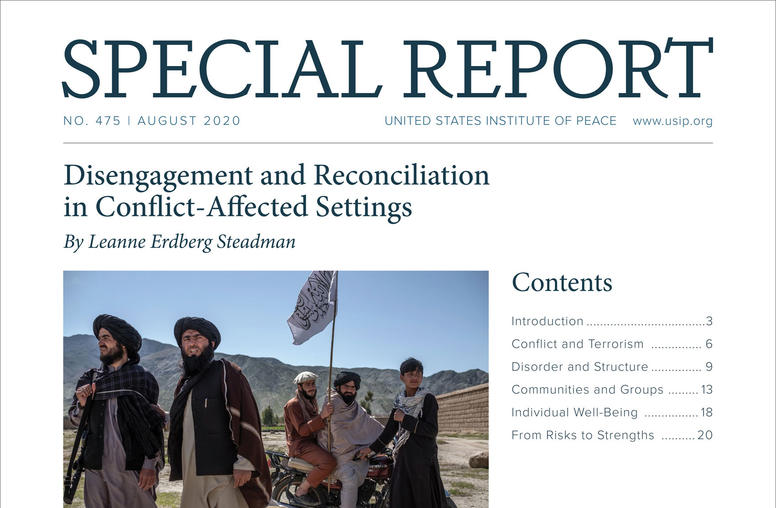Violent Extremist Disengagement and Reconciliation (VEDR) is the peacebuilding contribution to disengagement from violent extremism and reconciliation with local communities. It de-exceptionalizes violent extremism from other challenges that result from similar sets of risk factors and social environments by emphasizing peacebuilding and public health. The VEDR approach addresses the social, structural, and individual dynamics involved to promote belonging and offer an alternative identity that rejects violence to transform behavior, transform identities, and transform conflict.
Violent Extremist Disengagement and Reconciliation
Conventional rehabilitation efforts for violent extremism focus primarily on individual beliefs, ideologies, and attitudes. Instead, the VEDR approach moves beyond the narrow goal of disengagement from violent extremism by focusing on violent behavior as the fulcrum of change and considering the broader wellbeing and resilience of individuals and communities.
Goal: Behavioral disengagement from violent extremism and rejection of violence as a means to resolve conflict, express grievances, or pursue a goal.
Guidestar: Sustained, positive, inclusive engagement between disengaging persons and their communities can transform relationships, build empathy, encourage social learning, rehumanize others, foster reconciliation, generate a sense of belonging, and offer an alternative identity.
Approach: Lower barriers and open spaces for prosocial engagement with community members and institutions:
- Individual Barriers: Address cognitive barriers to help-seeking behavior to encourage a willingness to interact prosocially.
- Social Barriers: Reduce stigma and promote a sense of justice to open spaces in which prosocial engagement can occur sincerely.
- Structural Barriers: Link disengagement and reconciliation with efforts to address the legitimate grievances and underlying political or systemic tensions to build more resilient communities.
VEDR Principles
Violent Extremism is a Form of Violence
Principle 1: Learn From What We Know to De-exceptionalize Violent Extremism: Decades of psychology, criminology, and sociology research exists on why and how people exit roles and groups—including violent and ideological ones like gangs and cults. We know, in both cases, prosocial interactions with people outside the group and increased social network diversity are associated with desistance and disaffiliation. And we know, in both cases, the absence of a viable and tangible alternative is a significant barrier.
Violent extremism is only one of a host of adverse outcomes that result from a familiar set of risk factors and social ecologies. The literature on criminality, gang involvement, harmful drug use, addiction, self-harm, intimate partner violence, poor population health, fragility, and other forms of political instability and violent conflict highlight strikingly similar themes regarding community resilience and capacity, stigma, marginalization, isolation, relative deprivation, access to services, trauma and adverse childhood events, inequity, and other social a political grievances.
But instead of using decades of public health experience to affect behavior change, or peacebuilding tools to address underlying social challenges and transform conflict, violent extremism has been exceptionalized into its own securitized box, replete with practices derived from flawed assumptions and an overemphasis on the effectiveness of security and law enforcement imperatives alone. The VEDR approach takes violent extremism out of its cage to apply social-ecological interventions, trauma-informed care, stigma reduction practices, and behavioral and mental health and psychosocial support to improve access to care and services; encourage help-seeking behavior; and build community capacity, well-being, and resilience.
Communal, political, and interpersonal violence and conflict often predate a person’s engagement in violent extremism. Conflicts and legitimate grievances also often persist after their period of engagement, as do behavioral health challenges and other adverse outcomes. Defining success narrowly as disengaging from violent extremism without concern for well-being or other violent, antisocial, or adverse outcomes and behaviors is not just impractical, but also incredibly cynical. Peacebuilding and public health provide approaches to address these issues in an integrated way because they span individual, relational, communal, and institutional dimensions. De-exceptionalizing violent extremism applies these same practices for people disengaging from violent extremism.
Violent Extremism is Inherently Behavioral in Nature
Principle 2: Center Behavioral Health: Behavior change is an integral feature of public health practice, and it is time for it to feature more prominently in efforts to reduce violent extremism. Harm reduction approaches minimize risk and build capacity by shifting the focus of change from individuals alone to the social situations and structures in which they find themselves. Its practices are designed to minimize negative effects of high-risk behaviors by addressing complex challenges with low-threshold access to services and bottom-up alternatives. Harm reduction approaches offer pragmatic and compassionate strategies that begin by validating lived experience and meeting people where they are.
Principle 3: Apply Trauma-informed Care: Trauma is a significant barrier to disengagement, but it can be overcome if we prioritize addressing it. Trauma is associated with a range of behavioral health challenges and antisocial outcomes that make it difficult to build social bonds. Trauma can be associated with violent extremism in a variety of ways: trauma often contributes to a person’s initial mobilization into violent extremism; terrorist groups deliberately use trauma—and the therapeutic benefits of social belonging—to trap people into remaining engaged; and trauma can be associated with the shame, helplessness, and isolation of reintegrating into communities that may be hesitant to welcome them back.
Trauma is also gendered, and trauma-informed care needs to account for the unique experiences of women, girls, and sexual and gender minorities. Trauma-informed care is not a treatment method, but an ethos to enhance awareness and sensitivity across the entire social ecology to avoid re-traumatizing people—including health providers, law enforcement authorities, social workers, educators, employers, families, friends, and other social services institutions.
Principle 4: Prioritize Child Development, Socialization, and Welfare: Children are trafficked into violent extremist conflicts or born into conflict at no fault of their own. They are all victims of violent conflict, and they must be treated as such. Child development, protection, socialization, and wellbeing concepts can ensure that disengagement programs are sensitive to the unique needs of children returning from violent extremist conflicts.
Violent Extremism is Inherently Social in Nature
Principle 5: Encourage Prosocial Engagement: Disengagement from violent extremism is not just an individual’s personal decision; it is equally social in nature. Not only must individuals be willing to engage, so too must the social spaces in which that engagement can occur safely and sincerely.
VEDR is about rehumanization—not only rehumanizing society in the eyes of those disengaging, but also rehumanizing those disengaging in the eyes of society. It is a two-way street. Social network diversity has been shown to be a protective factor against an array of violent and antisocial outcomes, including engagement in violent extremism.
Principle 6: Reduce Stigma: Violent extremism is not the only area of practice that deals with highly-stigmatized populations engaged in a high-risk behavior. The public health, criminal justice, and social work areas of practice have dedicated decades to developing strategies for reducing stigma.
These strategies recognize the neurological power of language and framing to shape perceptions and opinions. For example, using people-first language in the media and policy discourse can avoid reinforcing the very identities disengaging persons need to shed. Additionally, narratives that emphasize redemption and acknowledge the structural dynamics that contribute to violence can reduce fears of recidivism and resentment over perceptions of special treatment.
Violent Extremism is a Form of Violent Conflict
Principle 7: Foster Justice and Accountability: Violent extremist organizations are genocidal organizations—guilty of cleansing entire ethnicities, targeting civilians, and devastating communities. Affected communities may feel angry at and betrayed by those disengaging from violent extremism, which can close off space in which meaningful prosocial engagement can occur.
And justice has two faces, criminal and social. When retributional justice fails to heal communities, restorative justice—a concept that focuses on repairing harm caused by an offense—is crucial to achieving reconciliation.
Violent extremism is an offense that targets entire communities, not only individuals, and community-based redemption rituals with deep roots in social ethos and community identity are uniquely positioned to provide a pathway for moving forward together. Restorative justice mechanisms—such as rituals, labeling, and dialogue—can transform identities, foster acknowledgement of harm, promote redemption, and open space for the community to offer restored membership.
Principle 8: Build Community Resilience: People disengaging from violent extremism often do so in the very same settings that contributed to their engagement initially. Interacting with the same social networks; engaging with the same political and social systems, structures, and norms; and accessing the same sources of information will result in a similar lived experience.
And without efforts to address those dynamics, disengagement is not sustainable. Prevention and disengagement are not two separate points on opposite ends of a continuum, but are integrally linked. Together, they close the circle and disrupt the cycle of violence. Peacebuilders know first hand how social and political systems and structures that encourage diversity, inclusive representation, and equitable distribution of goods and services can moderate intergroup conflict and promote cooperation—and how routinized prosocial interactions can transform identities, expand the boundaries of a group, and invite others into the franchise.
Featured Publications

Violent Extremist Disengagement and Reconciliation: A Peacebuilding Approach
This report presents a framework through which peacebuilders can foster disengagement from violent extremism and reconciliation between those disengaging and affected communities by examining the individual, social, and structural dynamics involved.

Disengagement and Reconciliation in Conflict-Affected Settings
This report examines how peacebuilding tools can help transform the individual attitudes, group relationships, and social ecosystems and structures needed to facilitate the effective disengagement and reconciliation of former members of violent extremist groups.